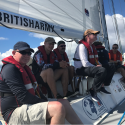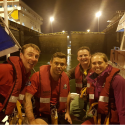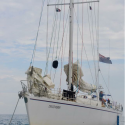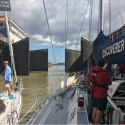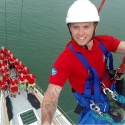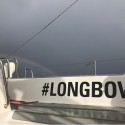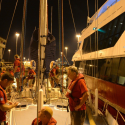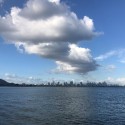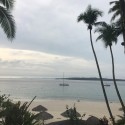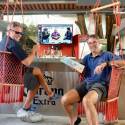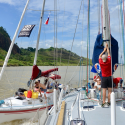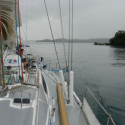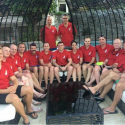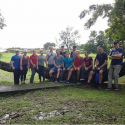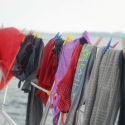On the 19th November 2017 two reservists from the University of London Officer Training Corps began a three-week Adventure Training exercise on-board Yacht ‘Discoverer’, one of the Army’s two Challenger 72’ Ocean going sail training yachts. The aim of Ex Pacific Longbow was to challenge participants in a demanding environment and to develop their individual, and team skills.
In true military style the exercise was broken down into three phases:
Phase 1: The Caribbean
Phase 2: The Transit of the Panama Canal
Phase 3: The Pearl Islands and Panama City
Phase 1: The Caribbean
Before slipping and embarking on the first phase the crew had the important task of ensuring that the boat is fit to sail, undertaking and necessary repairs and pack the boat with food provisions – referred to ‘victualling’ in the sailing world. With enough Nutella to last us 3 months let alone 3 weeks, the crew finally let slip and set of on their first sail. This was only a short sail up to Marigot Bay, located north of the island. The short sail acted as a training session for all, even the experienced among the crew, as many had not sailed on a 72′ before. Each watch was put through their paces, covering a number of evolutions such as tacking, gybing, taking reefs in reefs on the mainsail and shaking them out.
The crew got up to speed in good order and came alongside at Marigot Bay (St Lucia) with slick drills and safe practice. In just one day, a novice had gone from knowing nothing to tying a bowline in a warp and stepping ashore to get a stern line on. New words, new skills – always learning and improving.
The much awaited day sail to Martinique saw Red watch hoisting the main sail, foresail, staysail, and, getting a reef in. They were then fortunate enough to get further training value from getting the foresail down, and getting the staysail down as well for good measure. The journey itself was straightforward enough to navigate, but the rolling swell coming in from the Atlantic was accompanied by intermittent squalls with gusts of wind and lashing rain.
Within 48 hours the novice members of the crew have exceeded all expectations and came together as a competent and capable team, a testament to the positive and engaging character of a trained soldier.
Bonjour! In France (Martinique) we found ourselves! A hearty breakfast of the continental variety and a quick change of courtesy flag got the day started. The passage to Curacao promised open ocean sailing and no sight of land for days. With the passage to Curacao planned there was little left to do but fill up on water and check the fuel levels.
Setting sail at 1400 the Discoverer was on her way for all of 2 hours before whales were sighted, followed by dolphins surfing off the port bow. A collision with a large tanker was avoided thanks to some diplomatic radio transmissions and the crew got stuck into the watch routine. Plenty of opportunities for novices to practice sailing to a bearing and to develop confidence on deck. The sense of adventure and getting out of the comfort zone was abundantly apparent with a few metres of favourable swell behind us giving the yacht some decent movement, up and down and side to side.
The original plan of heading for Curacao changed. The Discoverer made for Bonaire (the B of the ABC islands) and came alongside rather than anchoring. With just enough clearance under the keel, the skipper got the Discoverer into position despite nearly having to reset and repeat the entire approach.
Having experienced a few days of ocean sailing, conducting everything from sail changes on a rising and falling fore-deck to getting the spinnaker up and flying; the crew were under no illusion as to what lies ahead. A four day sail to Shelter Bay at the entrance to the Panama Canal, skirting across the northern coasts of Venezuela and Colombia along the way. The stunning scenery serves to maintain morale, the weather continues to beat down upon the crew.
After shortly embarking on our four-day voyage, the spinnaker was up – making good speed in the right direction. A day of relatively plain sailing with favourable sea conditions. Preparing three meals a day for a crew of 15 comes with a number of challenges, the rolling sea making it no easy task and necessitating protective gear (coveralls) when in front of the hub. At 35-40 degrees inside the galley the additional layers make for unpleasant working conditions.
Dropping the spinnaker today injected some excitement as it became quite a feisty wrestling match; the spinnaker was close to being submerged and potentially cut away. Robust commands from the skipper and tons of physical courage saw the sail successfully recovered, a bit damp, in need of untwisting, but most importantly in one piece and in the boat. The night was full of big rollers and some gusty phases making for an interesting couple of watches during the dark hours
With the longest passage of the leg and phase one nearly complete, the final day of sailing in the Caribbean was a mixture of cruising under engine (very light wind), observing the large shipping vessels in the distance, avoiding the floating hurricane debris stuck in the currents, and taking the intricacy of meals prepared at sea to new culinary heights.
The last few hours of the journey into Shelter Bay were consumed by heavy rain, light winds, more rain and rolling seas. For the first time on this leg, waterproof jackets were required. With significantly reduced visibility and testing weather, the 0001-0400 watch were put through their paces. Discoverer pressed on and once within 5nm of Shelter Bay the skipper was roused from his bunk and took control for the heavily regulated entrance to the marina/canal zone.
Shelter Bay provided just that, shelter. Warm showers and a chance to get some laundry done by a machine were welcomed by all.
Discoverer remained in Shelter Bay for two days waiting for the allotted time slot to transit the canal. This allowed for final preparations and administration for what promised to be a once in a lifetime experience – transiting from one ocean to another via the Panama Canal.
Phase 2: The Transit of the Panama Canal
Final orders delivered, decks cleared and bespoke lines for handling through the locks laid out; conditions were set for a smooth transit. At the moment Discoverer left Shelter Bay the rain returned, on went the waterproof gear and slow was the progress to the anchorage where our Pilot was due to rendezvous at 1630 local time. Given the military convention for being ready ‘five minutes before’, Discoverer was at anchor in the holding area 2 hours before the Pilot was due to arrive. This provided a great opportunity to get someone up the mast for some excellent photos. Perhaps a bit of additional direction on where the halyards needed to run would have helped, as shortly after the first crew member came down, another was hauled up to reset the crossed lines.
Photo-shoot finished, the Pilot arrived at 1730 ‘Panama time’ but instantly proved just how experienced and knowledgeable he was. We were treated to a verbal history of the canal, an extensive rundown of his own personal experience on everything from cruise ships to container ships via education at the Panamanian Merchant Navy Academy.
Discoverer went through the first three locks (Gatun Locks) with one container ship, two tugs, and a large motor cruiser with roughly 80 tourists. We were also joined by a small yacht run by the Skeleton Sailing Crew, on an expedition around South America raising awareness of the rate of suicide among US military veterans. The initial experience of locking up to the Gatun lake was fantastic, moments of frantic activity juxtaposed with a lot of waiting quietly – the next day promises more of the same with some additional cruising through the lake and the chance to see some wildlife. The speed with which the crew are expected to raft up and then break away is considerable. What felt like a novice crew back in St Lucia is now a slick organisation oozing with confidence, tempered by level headed leadership and performing well at each point of asking. Every crew member is in absolute agreement that this is a once in a lifetime experience and all are acutely aware of how lucky they are to be able to say they have sailed through the Panama Canal.
The crew were up bright and early, ready for the new pilot to jump aboard and continue through the last sequence of locks. Shortly after the pilot joined us, he was informed that the engine of the small sailing yacht that had accompanied us the night before had failed and the Discoverer would need to provide assistance to the Skelton Sail Crew; through the form of rafting.
With the small yacht rafted to the side of us, the Discoverer continued through the final sequence of locks. On reaching the Pacific Ocean, we were greeted by a surprise proposal between two members of the Skelton Sailing Crew – we were honoured to be a part of their special moment. After short congratulations to the happy couple, we freed the vessel from us and said goodbye as we continued our journey on to Toboga, where we anchored up for the night. A small shore party went ashore to explore the quaint island.
Phase 3: The Pearl Islands and Panama
The Discoverer sailed onwards to Les Perlas (The Pearl Islands) for a few days – Contadora, then Isla del Rey (via Isla Mogo Mogo the ‘Survivor Island’).
We had finally reached paradise, an idyllic place where palm trees lined white sand beaches, like those featured in the Pirates of the Caribbean. Everyone had been looking forward to this part as much as the transit through the Panama Canal. A lot of the time was spent exploring the deserted islands, snorkelling and swimming.
On reaching our final destination Panama City, the crew were put to work to deep clean the boat and carry out any maintenance, ready for the next crew. After a day and a half of deep cleaning, the crew earned a well-deserved rest – 2 days R and R in Panama City. A majority of the crew treated themselves to a stay in a hotel after spending 3 weeks in a confined, hot and rather uncomfortable bed space and many explored the old town, which hosted an array of charming bistros and boutiques.
Ex Pacific Longbow challenged all participants, providing a dramatic and demanding environment which successfully developed individual sailing skills, as well as providing plentiful opportunity to develop team and leadership skills. The expedition was acknowledged by all to be a resounding success; a superb example of how the Ulysses Trust has an impact. Making once in a life opportunities accessible.

